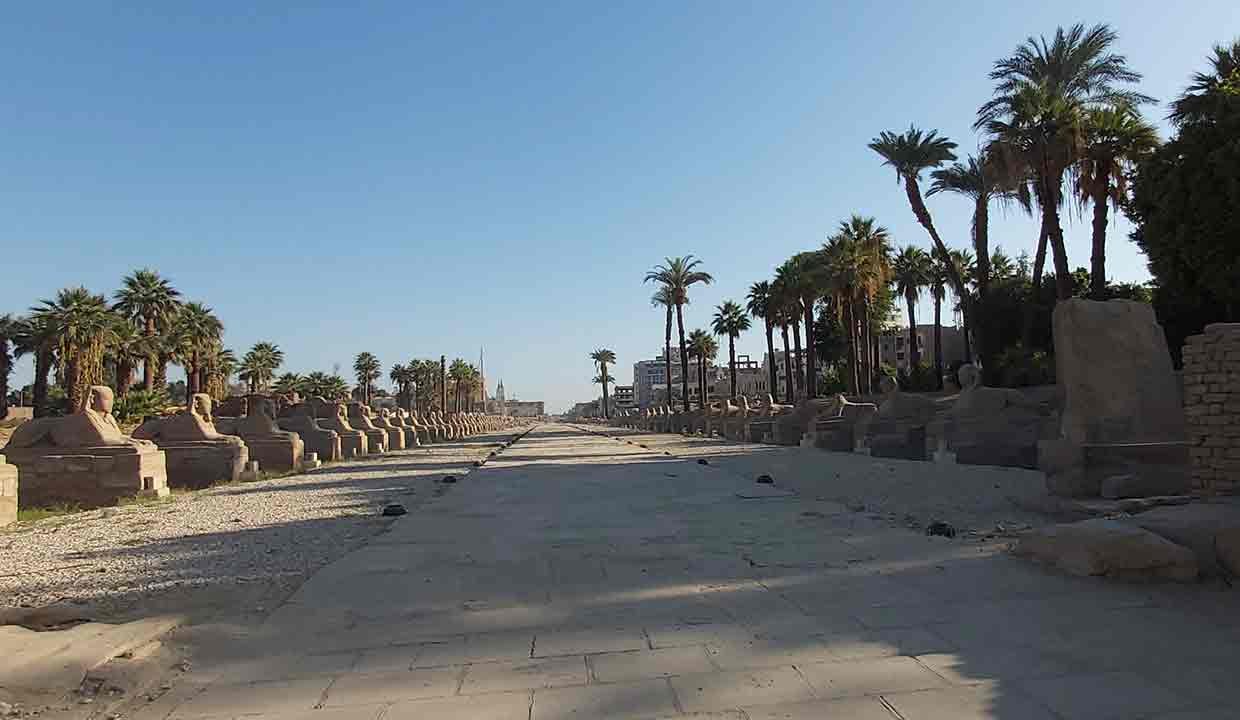Amazing Sphinxes:4 Facts about Echoes of Ancient Thebes.
Unearthed majesty awaits at the Avenue of the Sphinxes, where gods and kings once walked side by side.
The Avenue of the Sphinxes, known historically as the “Sacred Way,” is an emblematic testament to the architectural grandeur and religious devotion of the ancient Egyptians. Stretching over a distance of approximately three kilometers between the temples of Luxor and Karnak in modern-day Luxor (ancient Thebes), this grand processional way was flanked by hundreds of majestic human-headed sphinx statues, leading the faithful and the curious alike on a journey of divine significance.
Historical Background
The Avenue of the Sphinxes dates back to the reign of the New Kingdom Pharaoh Amenhotep III (around 1386-1349 BCE), who commissioned the initial construction. However, subsequent rulers, notably the Nubian Pharaoh Taharqa and the Ptolemaic rulers, later made additions and restorations to this monumental pathway.
Initially, the path was lined with ram-headed sphinxes symbolizing the god Amun. These were later replaced or supplemented with human-headed sphinxes, representing the union of the gods Ra and Amun.
This is part of the vast Karnak Temple complex, which is located along the river’s eastern shore. Pharaoh Sesostris I began the complex during the “Middle Kingdom” period, but it was continually improved throughout the Ptolemaic period, which was effectively the end of the Pharaonic era.
A Brief History Of Sphinx Avenue
The first phases of the Avenue of Sphinxes began during Queen Hatshepsut’s reign, with the construction of seven chapels. Unfortunately, none of the chapels exist today. Several years later, Pharaoh Nectanebo I decided to expand the original complex, building a 2.7-kilometer road or “pathway” flanked on both sides by hundreds of stone sphinxes. One interesting feature is that some of the sphinxes have ram’s heads rather than the traditional human head.
While one might expect such a vast and significant site as the Avenue of Sphinxes to always be visible, it was actually enveloped and hidden by Luxor’s unrelenting urban sprawl. Fortunately, in late 2011, the Egyptian government announced that the Avenue of Sphinxes had been fully restored and would be reopened to the public in an official ceremony.
Significance in Ancient Times
The Avenue of the Sphinxes was not just an ornamental feature; it played a crucial role during the opulent annual Opet Festival. During this celebration, statues of Amun, Mut, and Khonsu were paraded from the Karnak Temple to the Luxor Temple, symbolizing the rejuvenation of the kingship and the gods. The path provided a direct route, and the lined sphinxes were believed to offer protection and blessings for this sacred journey.
Architectural Marvels of The Avenue of the Sphinxes
- Sphinx Statues: The most striking feature of the avenue is, of course, the sphinxes themselves. While many of the original statues have been damaged or buried over time, efforts to restore them have uncovered statues with intricate details, showcasing the master craftsmanship of ancient Egyptian artisans.
- Inscriptions and Stelae: Between these statues, stelae and inscriptions provide insights into the religious beliefs, rituals, and events of the time. They often depict pharaohs offering gifts to the gods or scenes from the grand Opet Festival.
- Connecting Chapels and Gates: Along the avenue, small chapels and ceremonial gates were constructed. These structures often bore inscriptions and reliefs showcasing the reigning pharaoh’s devotion to the gods.
Modern Exploration and Restoration of The Avenue of the Sphinxes
For centuries, much of the avenue lay hidden beneath the sands or obscured by modern construction. Excavations in the 20th century, and more extensively in the 21st century, have unearthed a significant portion of the original pathway. The Egyptian government and international entities have been working collaboratively on restoration efforts to bring back the avenue’s ancient glory and enhance its appeal as a significant tourist attraction.
In recent times, parts of the avenue have been opened to the public, making it one of the must-visit archaeological sites in Luxor.
Conclusion
The Avenue of the Sphinxes, in its vastness and symbolic depth, stands as a monumental testament to ancient Egypt’s spiritual and architectural prowess. As the sun casts its golden hue over the statues and the worn stones of the pathway, visitors can almost hear the echoes of ancient processions and feel the weight of history under their feet. In its silent majesty, the Avenue of the Sphinxes invites us to journey back in time and immerse ourselves in the wonders of a civilization that continues to fascinate and inspire.
Explore Egypt Tours Tripadvisor


Comment (0)